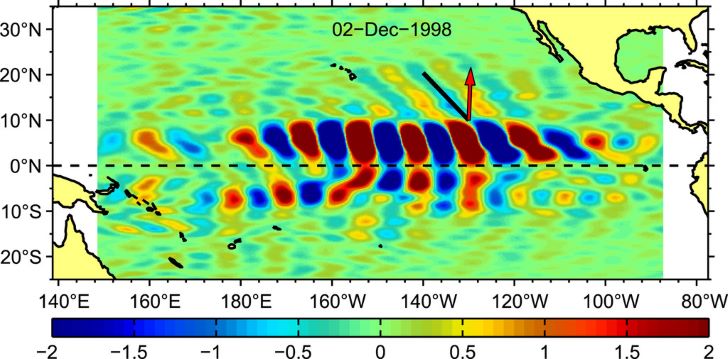Long-distance radiation of Rossby waves from the equatorial current system
Farrar, J. T., Durland, T., Jayne, S. R., and Price, J. F., 2021. Long-Distance Radiation of Rossby Waves from the Equatorial Current System. Journal of Physical Oceanography, 51(6):1947-1966. https://doi.org/10.1175/JPO-D-20-0048.1
Satellite sea surface height measurements on 2 Dec 1998, after filtering to emphasize the monthly period “tropical instability waves” that result from an instability or breakdown of the strong equatorial current system in the Pacific. (The units are centimeters.) The wavelike pattern on 10-20°N is associated with monthly period waves that radiate away from the unstable equatorial currents. The waves actually radiate farther than the this plot suggests. There is ample evidence that waves with periods of a month or longer (Rossby waves) radiate away from the major unstable current systems to affect variability at distances of up to 1000 km, but the spatial extent of this influence, and the factors determining that extent, have been difficult to assess. The reason for this difficulty is essentially that the observational evidence is mostly based on statistical inferences and data records that are limited in space and time, making it difficult to directly observe the wave propagation. Waves radiated from unstable currents are of interest because they can transmit energy and momentum efficiently over long distances and then transfer it to other motions (like the mean flow). In this study, we use measurements from satellite altimetry to show that sea surface height (SSH) variability throughout much of the North Pacific Ocean is coherent with the SSH signal of the tropical instability waves (TIWs) that result from instabilities of the equatorial currents. This variability has regular phase patterns consistent with freely propagating barotropic Rossby waves radiating energy away from the unstable equatorial currents, and the waves clearly propagate from the equatorial region to at least 30°N. The pattern of SSH variance at TIW frequencies exhibits remarkable patchiness on scales of hundreds of kilometers, which we interpret as being due to the combined effects of wave reflection, refraction, and interference. North of 40°N, more than 6000 km from the unstable equatorial currents, the SSH field remains coherent with the near-equatorial SSH variability, but it is not as clear whether the variability at the higher latitudes is a simple result of barotropic wave radiation from the tropical instability waves. Even more distant regions, as far north as the Aleutian Islands off of Alaska and the Kamchatka Peninsula of eastern Russia, have SSH variability that is significantly coherent with the near-equatorial instabilities. Image provided by Tom Farrar.

